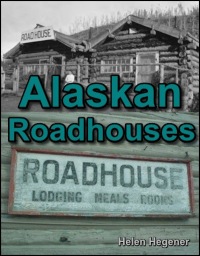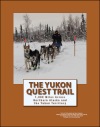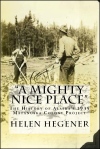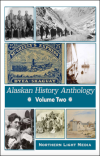The handwritten caption on the front of this photo by early Alaskan photographer Frank H. Nowell, showing three women, five men and three dogs, reads, “Anna Ruhl’s Road House – Deering, Alaska, September 25th 03.” There are two signs on the gable end of the building (to the viewer’s right): one reads ‘Restaurant,’ the other says ‘Bunk Room.’
The village of Deering, located on a sandy spit on the Seward Peninsula where the Inmachuk River flows into Kotzebue Sound, 57 miles southwest of Kotzebue, was established in 1901 as a supply station for interior gold mining near the historic Malemiut Eskimo village of Inmachukmiut. According to Donald J. Orth‘s Dictionary of Alaska Place Names, a post office was located here in 1901 and the name came from the schooner Abbie M. Deering, which was present in the area around 1900.

Capt. Winchester’s sketch of the Schooner Abbie M. Deering from his book: “Leaving Lynn, Nov. 10, 1897”
A first-hand account, written by Captain James D. Winchester and published in 1900, relates the story of the wooden schooner Abbie M. Deering, built in 1883, which was bought by a company of twenty men who wanted to sail to the Alaskan gold fields during the Klondike Gold Rush. They left Massachusetts in November 1897, with Winchester, a merchant marine and the only seafaring man among them, at the helm. Capt. Winchester taught his crew to sail en route, and they sailed around the tip of South America, passed through the Straits of Magellan, and arrived at San Francisco five months later. They sold the ship, which was nicknamed ‘Diver,’ according to Capt. Winchester, “for the vigorous way in which she dove into a sea, giving many of us a good wetting in spite of every precaution.”
Records kept by the U.S. Department of the Interior show the schooner did eventually make it to Alaska, and some reports say the community of Deering was settled by its crew. There are apparently no records of Anna Ruhl’s roadhouse at Deering, and an extensive search turned up only the photograph above.
On August 26th, 1903, the town’s namesake, the Abbie M. Deering, departed Nome with a cargo of thirty tons of cigar case and mats, bound for Seattle and way ports. On September 4th, the schooner met heavy currents and an early morning fog, and drifted onto a reef on a small island on the northwest side of Akutan Pass, in the Aleutian Islands. The crew worked for thirty-eight hours trying to pull the vessel off of the reef. The schooner’s master assisted the crew of the U S Revenue Cutter Manning, upon their arrival, in the removal of the thirty one passengers and eight crewmen. The mate was left in charge of the wreck, and all the passengers and crew, except a few who remained in Dutch Harbor, went on to Seattle. The ship and its cargo was reported a total loss. Rudyard Kipling’s 1897 novel Captains Courageous mentions the Abbie M. Deering by name.

Alaskan Roadhouses
"Alaskan Roadhouses, Shelter, Food, and Lodging Along Alaska's Roads and Trails," by Helen Hegener, published by Northern Light Media in 2016. 6" x 9", over 100 black/white photographs, 284 pages. $24.95 plus $5.00 for First Class shipping.
$29.95






























